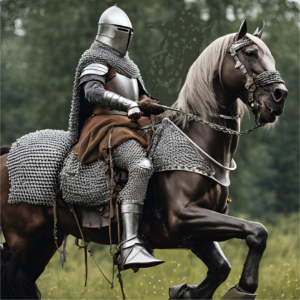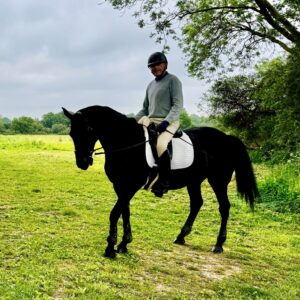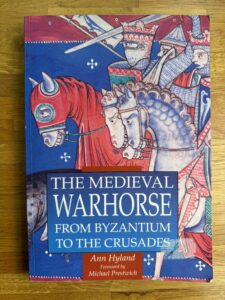Warhorse!
 I ride horses. I know enough about them to wonder how these usually-gentle, nervous beasts were trained to be instruments of war. What could persuade a prey animal – one that has evolved to run from danger – to hurl itself headlong into battle? When I was planning the Rune Song series, the warhorse was a gap in my knowledge that I had to research.
I ride horses. I know enough about them to wonder how these usually-gentle, nervous beasts were trained to be instruments of war. What could persuade a prey animal – one that has evolved to run from danger – to hurl itself headlong into battle? When I was planning the Rune Song series, the warhorse was a gap in my knowledge that I had to research.
A clash of cultures
I focused that research on medieval Europe, the world on which Rune Song is based, while knowing that other cultures developed different forms of cavalry. The Arab world, for example, tended to have lighter, faster, more manoeuvrable beasts. A Saracen warrior could fight not only with sword or lance, but with a short, recurved bow. A dextrous rider could shoot from the saddle in any direction, while guiding his galloping mount with his knees. Such tactics inflicted terrible losses during the crusades, when Saracen arrows brought down many warhorses before their riders could engage.
In feudal Europe, the warrior class did not consider the bow a ‘knightly’ weapon, an attitude which shaped mounted warfare throughout the era. In the early medieval centuries, the primary weapon for a mounted man at arms was the lance, held mid-shaft and wielded like a sword on a pole. By the Norman conquest, with the increased use of chain mail, the lance had became an impact weapon, with a narrower blade to punch through armour. It was held further back on the shaft for greater reach, and couched under the arm for balance. The weight of armour demanded bigger horses. Warfare entered the era of the cavalry charge, as when William the Conqueror broke the Saxon shield wall at Hastings.
Size, build, and training
The Norman warhorse would still have seemed small to modern eyes. Evidence suggests heights of 15 to 15.2 hands (60-62”) or more at the shoulder, though they were probably bigger by the era of plate armour. A man’s mount today would typically be 16 to 16.2 hands (64″ to 66″). Men’s average height in the 11th century would only have been 1-2” lower than today. High-backed saddles held the rider in place, so much of the impact when charging knights met, at closing speeds of around 40mph, would have been transmitted to the horse. They were short-backed, well-muscled to withstand the shock, with an arched neck, and had powerful hindquarters for speed and agility. They would have uncoiled like a spring at the touch of a spur. The best of them were called destriers – label of quality rather than breed – and most would have been stallions, for their aggression.
They were also highly trained. A horse’s natural behaviour is to shy away from collision. A knight needed his mount to hold a steady line into the face of danger; the unswerving power behind his lance head. They formed a lethal, tightly-bonded partnership; in close combat the horse became a living weapon; a small signal could unleash pile-driver blows with the hind legs to clear enemies behind. Another movement would make the beast dance to the side to evade a strike. Even amidst the turmoil of the melee, a trained destrier would feel, understand, and obey the subtlest of movements. The horse needed to have total trust in its rider, who had to command lightly, mainly with leg and weight. One hand would be holding a weapon, the other a shield that inhibited the use of reins. The modern equestrian discipline of dressage was born on the tournament fields.
Tournaments: high risk, high reward
Tournaments were a crucial training ground for war, both for horse and rider. They were held all over Europe, and announced far enough in advance to attract entries from distant lands. They were highly competitive, and high risk, but potentially lucrative. England’s William Marshall began his tournament career in 1167 on a borrowed horse, but in a ten-month spree he and a partner knight vanquished 103 knights, claiming their horses, harness, and armour.
A good warhorse was valuable. We know that a knight might typically spend a year’s revenues from his lands to buy his mount. Comparisons with the present day are problematic, but evidence suggests modern values of £35,000+ for an unexceptional beast, while destriers with a proven tournament history could be worth ten times that amount. Paradoxically, the best warhorses became too valuable to be risked in war, but were retired for bloodstock breeding like modern Olympic champions.
Real-life inspiration
One warhorse that features throughout the Rune Song series. Allier, an ‘almost pure black stallion, with a distinctive lightening around the muzzle,’ appears in Book 1, Hammer of Fate, and becomes almost a character in his own right in Book 2, Runes of Battle, and Book 3, Blood of Wolves. I confess he was inspired by a living horse.
 Meet Ida. She’s a mare, not a stallion, and she’s far too sweet-natured to be a warhorse, but she did inspire me to write of the almost telepathic connection that grows between horse and rider. This goes beyond the simple commands of leg and rein that I deliver so imperfectly, for Ida mirrors my moods. If I am happy, she will be happy, and light in my hands. If I come to her stressed, she will be upset until my mood softens. (And she’s good at making that happen.) Then she will relax, as if she’s letting out a thankful sigh.
Meet Ida. She’s a mare, not a stallion, and she’s far too sweet-natured to be a warhorse, but she did inspire me to write of the almost telepathic connection that grows between horse and rider. This goes beyond the simple commands of leg and rein that I deliver so imperfectly, for Ida mirrors my moods. If I am happy, she will be happy, and light in my hands. If I come to her stressed, she will be upset until my mood softens. (And she’s good at making that happen.) Then she will relax, as if she’s letting out a thankful sigh.
For riding cognoscenti, Ida is a 15 year old, 16.3 hands Warmblood who has competed internationally at show jumping. She is beautiful, and knows it, so she earns her stable name of ‘Princess’. She is also the most affectionate horse I’ve known in over 30 years of riding.
Here’s a short video clip of a ride in my local woods. File size restrictions limit it to a mere 45 seconds, but you’ll glimpse the exhilaration of the partnership.
Further reading
 One useful source for my research was Ann Hyland’s ‘The Medieval Warhorse’. Hyland describes the historical context well, and the evolving styles of warfare. Further research would be needed if you are looking for the training methods of warhorses.
One useful source for my research was Ann Hyland’s ‘The Medieval Warhorse’. Hyland describes the historical context well, and the evolving styles of warfare. Further research would be needed if you are looking for the training methods of warhorses.
You’ll find the Amazon pages for the Rune Song series, with their reviews, here:
Amazon UK:
Amazon.com: